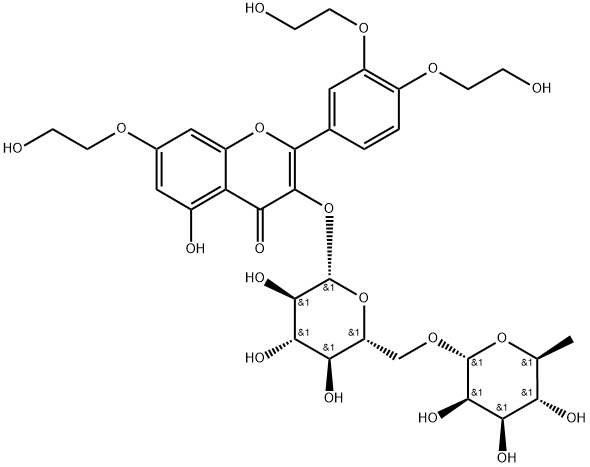Troxerutin CAS# 7085-55-4
Troxerutin, also known as vitamin P4, is a naturally occurring flavonoid that can be isolated from tea, coffee, grains as well as veggies. It has a range of beneficial pharmacological as well as restorative activities, consisting of antioxidant, anti-inflammatory, anti diabetes as well as anti-tumor.
Troxerutin, chemical name 7,3,4,-three (O-(2-hydroxyhexyl)) rutin, which is a mixture of hydroxyethyl rutin acquired by hydroxyethylation of rutin, is yellow, yellow-green or light brown-yellow powder, odorless, slightly salty, hygroscopic, and also the primary product of hydrolysis is hyperin. Troxerutin is a semi-synthetic flavonoid substance made from rutin with hydroxyethylation. It can prevent the aggregation of red cell and platelets, increase blood oxygen content, boost microcirculation, as well as promote the formation of new members vessels. It is the primary element of Vinaorutong, often made right into tablets as well as shots.
发送询盘
Troxerutin CAS# 7085-55-4
| Troxerutin Basic information |
| Product Name: | Troxerutin |
| Synonyms: | 3??,4??,7-Tris[O-(2-hydroxyethyl)]rutin, Troxerutin;Troxerutin??Trihydroxyethylrutin;3′,4′,7-Tris(hydroxyethyl)rutin;3,5-Dihydroxy-3′,4′,7-tris(2-hydroxyethoxy)flavone 3-rutinoside;Factor-P-zyma;2-[3,4-BIS(2-HYDROXYETHOXY)PHENYL]-3-[[6-O-(6-O-DEOXY-A-L-MANNOPYRANOSYL)-BETA-D-GLUCOPYRANOSYL]OXY]-5-HYDROXY-7-(2-HYDROXYETHOXY)-4H-1-BENZOPYRAN-4-ONE;Trihydroxylrutin;Trihydroxyethylrutoside |
| CAS: | 7085-55-4 |
| MF: | C33H42O19 |
| MW: | 742.68 |
| EINECS: | 230-389-4 |
| Product Categories: | Intermediates & Fine Chemicals;Pharmaceuticals;Natural Plant Extract;Miscellaneous Natural Products;Inhibitors;Plant extracts;Herb extract;POSORUTIN;Aromatics;Heterocycles;Oligosaccharides;TROXEPURE;7085-55-4 |
| Mol File: | 7085-55-4.mol |
 |
|
| Troxerutin Chemical Properties |
| Melting point | 181??C |
| Boiling point | 1058.4??65.0 ??C(Predicted) |
| density | 1.65??0.1 g/cm3(Predicted) |
| storage temp. | Sealed in dry,Store in freezer, under -20??C |
| solubility | Freely soluble in water, slightly soluble in ethanol (96 per cent) and practically insoluble in methylene chloride. |
| form | Solid |
| pka | 5.92??0.40(Predicted) |
| color | Light Yellow to Yellow |
| Merck | 14,9789 |
| BRN | 4778232 |
| InChIKey | KMPBUGGPUQOWMJ-NXPSPVSKSA-N |
| CAS DataBase Reference | 7085-55-4(CAS DataBase Reference) |
- 2
- 2-diallylpent-4-en-1-amine
- 4
- 95-16-9
- Ammonium sulfamate
- Benzothiazole
- cas:67889-00-3ح2
- cas:83524-75-8 | pigment black 32
- cas:928836-00-4 | 2
- cas:932745-70-5 | 4
- Chemical Minerals
- Coconut diethanolamide
- Daily Chemicals
- discount
- for sale
- General pvc resin
- hexyl D-glucoside
- in stock
- Lauramidopropyl betaine
- LAURIC ACID MONOETHANOLAMIDE
- Petroleum Additives
- Plasticiser
- Ploymers
- price
- PVC
- quotation
- Raw Materal
- Remove term: Petroleum Additives Petroleum Additive
- SODIUM ETHYL 2-SULFOLAURATE
Related Products
Chemical Name: Imazalil Sulfate
CAS No.: 58594-72-2
Molecular Formula: C14H14Cl2N2O.H2SO4
Molecular Weight: 395.26
Appearance: Solid
Terpene resin is a type of natural resin derived from terpenes, which are organic compounds found in various plants. It is known for its aromatic properties and is commonly used in the production of fragrances, flavorings, and as a component in adhesives and coatings within the chemical industry. Terpene resin offers a range of benefits, including enhancing the solubility of essential oils and providing a stable base for various applications. Its natural origin makes it a preferred choice for eco-friendly products.
Chemical Name: STODDARD SOLVENT
CAS No.: 64742-88-7
Appearance: Colorless or Light Yellow Liquid
Octocrylene is an organic compound widely recognized for its potent UV-filtering properties, making it an essential ingredient in sunscreens and other skincare products designed to protect the skin from harmful ultraviolet radiation. With the chemical name 2-(4-Methylbenzyl)-2H-benzotriazole-5-methyl, octocrylene is a stable and photostable molecule that provides broad-spectrum protection against both UVA and UVB rays.
This oil-soluble chemical is valued for its ability to absorb UV radiation effectively, converting it into heat without causing skin irritation or staining clothes. Octocrylene is often used in combination with other UV filters to enhance the sun protection factor (SPF) of formulations, ensuring a balanced and comprehensive defense against sun damage.
As a lipophilic compound, octocrylene is compatible with various cosmetic and dermatological formulations, contributing to the development of lightweight, non-greasy sunscreens. Its chemical structure allows for a high degree of safety and efficacy, making it suitable for a wide range of skin types, including sensitive skin.
In summary, octocrylene is a reliable and efficient UV filter, pivotal in the formulation of modern sunscreens that offer advanced protection against the sun’s harmful effects while maintaining skin comfort and product aesthetics.
Chemical Name: Choline salicylate
CAS No.: 2016-36-6
Molecular Formula: C12H19NO4
Molecular Weight: 241.28
Appearance: Red-Brown Crystal
Chemical Name: UV-120
Other Name: (2’,4’-Di-tert-butylphenyl 3,5-di-tert-butyl-4-hydroxybenzoate)
CAS No.: 4221-80-1
Molecular Fomula: C29H42O3
Molecular weight: 438.66
Assay: ≥99%(LC)
Chemical Name: Dehydrocholic acid
Synonyms: Acide dehydrocholique; Triketocholanic acid
CAS No.: 81-23-2
Molecular Formula: C24H34O5
Molecular Weight: 402.53
Appearance: Powder
Chemical Name: Potassium Castorate
CAS No.: 8013-05-6
Molecular Formula: C57H107K3O12
Molecular Weight: 1101.74718
Appearance: Yellow Liquid
Product name:HYDROXYPROPYL GUAR HYDROXYPROPYLTRIMONIUM CHLORIDE
Purity:99%
Appearance:Light Yellow Powder
Package:Customized according to customer needs.
Sample:Available
Silicone oil, known for its chemical designation as dimethicone or polydimethylsiloxane, is a synthetic polymer with a backbone of alternating silicon and oxygen atoms, creating a highly versatile and stable compound. It is renowned for its exceptional lubricating properties, heat resistance, and non-toxic nature, making it a staple in various industries, including cosmetics, automotive, and aerospace.
This hydrophobic, non-volatile oil is valued for its ability to provide a smooth, non-greasy feel and to form stable emulsions with other ingredients. In personal care products, silicone oil is used to impart a silky texture, reduce friction on the skin, and create a protective barrier against environmental stressors without clogging pores.
Silicone oil’s chemical inertness and resistance to oxidation contribute to its long shelf life and stability in formulations. It is also appreciated for its compatibility with a wide range of substances, allowing for the creation of multifunctional products.
In summary, silicone oil is a reliable and multifaceted ingredient, offering a combination of performance, safety, and sensory benefits. Its use in a variety of applications reflects its versatility and enduring appeal in the marketplace.
Chemical Name: Ammonium Iron(II) Sulfate
Synonyms: Diammonium iron bis(sulphate); iron (ii) ammonium sulfate
CAS No.: 10045-89-3
Molecular Formula: FeH5NO4S
Molecular Weight: 170.95
Chemical Name: 1,1,2,2-Tetrachloroethane
Other Name: Tetrachlorethane
CAS No.: 79-34-5
Molecular Formula: C2H2Cl4
Molecular Weight: 167.85
Appearance: Liquid



















